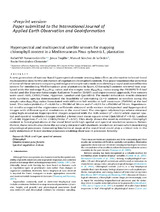Hyperspectral and multispectral satellite sensors for mapping chlorophyll content in a Mediterranean Pinus sylvestris L. plantation
Autor
Navarro Cerrillo, Rafael M.
Trujillo, J.
Sánchez de la Orden, Manuel
Hernández Clemente, Rocío
Editor
Science DirectFecha
2014Materia
Multi spectral sensorsHiper spectral sensors
Chlorophyll Mediterranean pine forests
Spectral vegetation indices
METS:
Mostrar el registro METSPREMIS:
Mostrar el registro PREMISMetadatos
Mostrar el registro completo del ítemResumen
A new generation of narrow-band hyperspectral remote sensing data offers an alternative to broad-band multispectral data for the estimation of vegetation chlorophyll content. This paper examines the potential of some of these sensors comparing red-edge and simple ratio indices to develop a rapid and cost-effective system for monitoring Mediterranean pine plantations in Spain. Chlorophyll content retrieval was analyzed with the red-edge R750/R710 index and the simple ratio R800/R560 index using the PROSPECT-5 leaf model and the Discrete Anisotropic Radiative Transfer (DART) and experimental approach. Five sensors were used: AHS, CHRIS/Proba, Hyperion, Landsat and QuickBird. The model simulation results obtained with synthetic spectra demonstrated the feasibility of estimating Ca + b content in conifers using the simple ratio R800/R560 index formulated with different full widths at half maximum (FWHM) at the leaf level. This index yielded a r2 = 0.69 for a FWHM of 30 nm and r2 = 0.55 for a FWHM of 70 nm. Experimental results compared the regression coefficients obtained with various multispectral and hyperspectral images with different spatial resolutions at the stand level. The strongest relationships where obtained using high-resolution hyperspectral images acquired with the AHS sensor (r2 = 0.65) while coarser spatial and spectral resolution images yielded a lower root mean square error (QuickBird r2 = 0.42; Landsat r2 = 0.48; Hyperion r2 = 0.56; CHRIS/Proba r2 = 0.57). This study shows the need to estimate chlorophyll content in forest plantations at the stand level with high spatial and spectral resolution sensors. Nevertheless, these results also show the accuracy obtained with medium-resolution sensors when monitoring physiological processes. Generating biochemical maps at the stand level could play a critical rule in the early detection of forest decline processes enabling their use in precision forestry.

